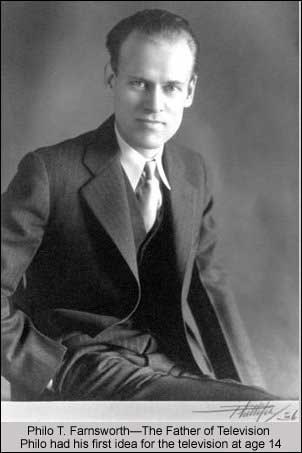Philo T. Farnsworth
Philo Taylor Farnsworth was an American inventor. He is best known for inventing the first fully electronic television system, including the first working electronic image pickup device (video camera tube), and for being the first to demonstrate fully electronic television to the public. In his later life, Farnsworth also invented a small nuclear fusion device known as a fusor (Wikipedia.org). Farnsworth was a member of The Church of Jesus Christ of Latter-day Saints, sometimes casually called the Mormon or LDS Church.
Farnsworth was born on August 19, 1906, in Beaver, Utah, to Lewis Edwin and Serena Bastian Farnsworth. The family then relocated to Rigby, Idaho, where Lewis Farnsworth farmed. The Farnsworth home in Rigby had electric lighting, and power hoists to lift hay into the barn. Farnsworth converted a hand-powered washing machine to electric power by winding an armature to construct an electric motor.[1] Philo read technology magazines and developed an early interest in electronics. He excelled in chemistry and physics at Rigby High School, and produced sketches and prototypes of electron tubes.
Philo served in the U.S. Navy briefly, returned to Idaho, and then moved with his family to Provo, Utah, where he attended Brigham Young University. In Provo, Lewis passed away, and Philo was forced to withdraw from college. The family downsized into a duplex, where Philo met electronics-oriented Cliff Gardner, a neighbor. The two moved to Salt Lake City to start a radio repair business, but it failed, and Gardner returned to Provo. Farnsworth was able to study at the University of Utah in Salt Lake City. While there, he met Leslie Gorrell and George Everson, who agreed to finance Farnsworth's television research. They established a lab for Farnsworth in Los Angeles. After marrying Elma “Pem” Gardner, Cliff Gardner's sister, Farnsworth relocated to L.A.
The ideas for inventing the television didn't come out of thin air. Much foundational work had gone on before Farnsworth's innovations, and other inventors simultaneously were developing TV receivers. But Farnsworth designed and built the world's first working fully electronic television system, employing electronic scanning in both the pickup and display devices, which he first demonstrated to news media on September 1, 1928, and to the public at the Franklin Institute in Philadelphia on August 25, 1934.[2] Some aspects of Farnsworth's 1930 camera and receiver designs remain in use today. Farnsworth's early patent applications helped him in later disputes with RCA.
- In 1930, Vladimir Zworykin, who had been developing his own all-electronic television system at Westinghouse, in Pittsburgh, since 1923, was recruited by RCA and visited Farnsworth's laboratory. Zworykin was impressed with the performance of the Image Dissector and had his engineers make a working copy of it, though he saw that the dissector's need for excessive light requirements made it impractical. In 1931, David Sarnoff of RCA offered to buy Farnsworth's patents for USD$100,000, with the stipulation that Farnsworth become an employee at RCA, but Farnsworth refused; in June of that year Farnsworth joined the Philco company and moved his laboratory to Philadelphia, along with his wife and two children (Wikipedia.org).
Several companies were progressing with TV technology, both in America and Europe, and the inventors and developers of these companies occasionally interacted, just as companies merged. Competition yielded duplicate claims and lawsuits, in which Farnsworth became embroiled. Farnsworth lost his son, Kenny, in 1932, and went through a divorce shortly thereafter. He began to struggle with depression. Philco let him go, and Farnsworth returned to his own lab. By 1936, Farnsworth's company was transmitting regular entertainment programs experimentally, even as Farnsworth produced other inventions unrelated to TV.
- In 1938, he established the Farnsworth Television and Radio Corporation in Fort Wayne, Indiana, with E.A. Nicholas as president, and himself as director of research. In 1939, Farnsworth sold his television patents to RCA Victor for $1 million. The New York World's Fair showcased electronic television sets in April 1939, and soon afterward, RCA electronic televisions went on sale to the public. Farnsworth Television and Radio Corporation was purchased by International Telephone and Telegraph (ITT) in 1951, and Farnsworth then worked for ITT. During his time at ITT, Farnsworth worked in a basement lab known as “the cave” on Pontiac Street in Fort Wayne. From here he introduced a number of breakthrough concepts, including: a defense early warning signal, submarine detection devices, radar calibration equipment, and an infrared telescope (Wikipedia.org).
ITT funded Farnsworth's research into fusion, but it was expensive. The company eventually severed the division, and eventually, its relationship with Farnsworth. Farnsworth had relapsed into depression, and earned medical retirement from ITT. Farnsworth returned to Provo to work with BYU and earned an honorary doctorate. He established businesses there and in Salt Lake, but funding failed. Farnsworth contracted pneumonia, and died March 11, 1971.
Farnsworth's wife Elma Gardner "Pem" Farnsworth fought for decades after his death to assure his place in history. Farnsworth always gave her equal credit for creating television, saying "my wife and I started this TV." She died on April 27, 2006, at the age of 98. Philo Farnsworth had been credited as the "father of television." Scientific American Magazine called him one of the ten greatest mathematicians of his time.[3] At his death, Farnsworth held 300 U.S. and foreign patents. His inventions contributed to the development of radar, the infra-red night light, the electron microscope, the baby incubator, the gastroscope, and the astronomical telescope.
